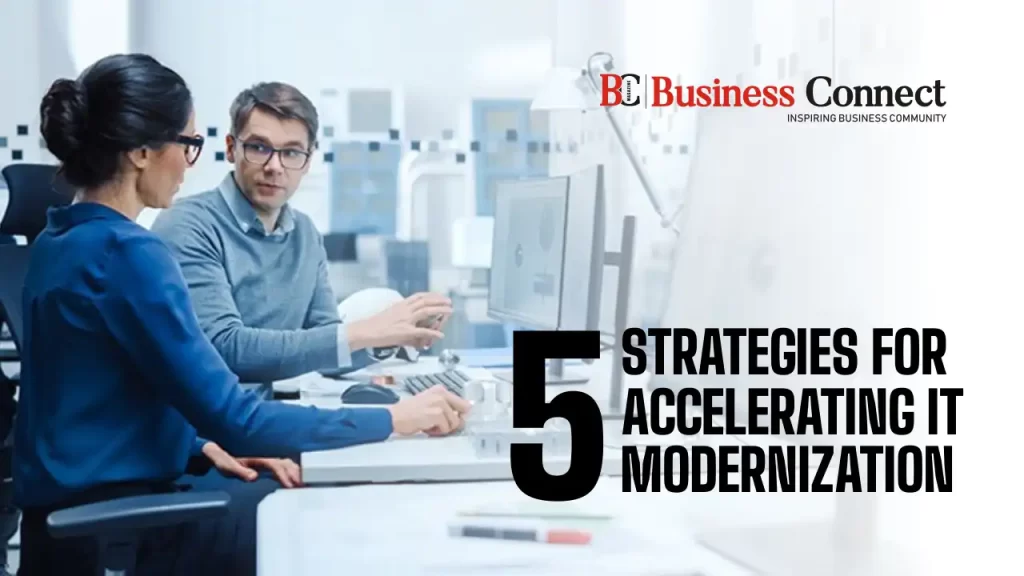5 Strategies For Accelerating IT Modernization
by Jaya Pathak
In modern era, where the technological landscape is evolving rapidly, the zest to accelerate, modernize and innovate IT infrastructure should be taken into account. IT leaders are facing the challenge of not just modernizing but also keeping an accelerated pace at the same time.
Business needs to accommodate swiftly to make profit from the emerging opportunities and be competitive. As the new technologies are transitioning from specific to general, ITians are facing the challenges.
Why do we need to accelerate modernization
The need to accelerate IT modernization arises from the alignment with the growing business needs and technological advancements. According to a report, organizations categorised as digital leaders are confident in the Return of Investment (ROI) from their digital initiatives. Howsoever, this journey of modernization often faces many hurdles such that even typical projects take too much time to complete.
Strategies to foster IT modernization
In order to expedite IT modernization efforts and to derive a meaningful outcome, IT icons should adopt some strategic approaches. Here presenting five chief strategies to accelerate IT modernization:
1. Turn modernization into a process rather an event:
Modernization is not a one-time event but a continual process. By treating modernization as a continual process, organizations can thus can adapt technological shifts. Companies or organization that really want to do good will have to turn modernization into a process instead of an event. You have the process to which you should adhere to in order to make it a ‘continual function’ within IT.
Robert Dvorak, president and CEO of advisory firm BlueHour Technology, worked with one CIO who managed the IT environment like an investment portfolio and ranked components as either buy, hold or sell.
2. Create a guiding framework:
Michael Bradshaw, who hold the CIO position at Kyndryl developed a framework with five guiding principles which will facilitate IT decisions. The principle include data centric, platform first, cloud based, automation led and zero trust for security purpose from the very beginning. These guiding principles helps the organization to accelerate faster. It guides them while decision making process and to remain focused on the principle-driven decisions. It acts like a position paper.
In order to illustrate how this framework helps to accelerate IT, Bradshaw pointed towards “modernizing the core business it had inherited”. Guided by the framework and platform first principle, IT directly selects two new and modern platforms by adopting their processes.
Thus, with such a structured approach, faster decision-making is aligned with strategic objectives.
3. Prioritize in terms of value:
It should be noted that all the efforts in the arena of modernization can not be promised to yield equal benefits. It is important to note that motion is not always progress. Focus should be given on the ‘right modernization efforts’ which is the key to accelerate modernization success.
Always prioritize the projects that align with the goals of organization and gives a tangible value. Thus, you should focus on understanding the needs of your business and focus on critical areas. In this manner, CIOs can drive accelerated and the purposeful outcomes of modernization can be achieved.
4. Focus on the foundation for modernization:
A strong IT-business alignment is required for a solid foundation. CIOs who don’t have the IT- business alignment, waste their time in chasing modernization initiatives that are not needed. CIOs can optimize resource allocation and eliminate redundant efforts by ensuring that modernization initiatives directly contribute to business value.
Another key element is the ability to score the needs of modernization based on the value that the project will deliver to the business and how each modernization project could help in accelerating other modernization initiatives. A modernization project which eliminates interdependence and introduce complexity in one area, makes the other much easier and quicker to moderate.
5. Applying Agile principles:
It is generally advised by the experts to use agile principle to get quick wins and incremental advancements if possible. Large modernization projects should be broken down into manageable increments using the agile methodology.
By the adoption of continuous integration and deliverypractices which enables rapid iteration and deployment ensures a quicker realization of benefits. Adoption of agile principle and breaking down large projects into smaller one means that business is benefited and ROI is fastening. CIOs should think the process of modernization as a marathon which has ‘incremental sprints’ to build capabilities and services.
Conclusion:
By implementing such strategic approach, organization can speed up the modernization journey and make profit through the emerging technology more effectively.



